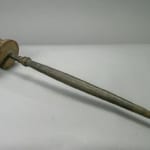Kuba Ceremonial Hoe, 20th Century CE
Wood, Iron
4.5 x 39
PF.5965
Further images
The Kuba peoples, famed for their figurative palm wine cups and fine textiles, have a tradition called Ani kiom. This literally translates as “offering a hoe.” When a young woman...
The Kuba peoples, famed for their figurative palm wine cups and fine textiles, have a tradition called Ani kiom. This literally translates as “offering a hoe.” When a young woman was married off and preparing to leave her family, her mother would present her with the gift of a hoe in the presence of select relatives. Although the hoe is perfectly functional, its primary use is purely symbolic. Before bestowing it upon her daughter, the mother would pretend to till the soil with it. As she presents this gift to her daughter, the mother informs her that it is not a present, but a symbol of the hard work that she will be required to perform for her new family. The hoe also symbolizes both the laborious working of the earth and the bounty of nourishing crops. This remarkable hoe is surely one of the most gorgeous examples. The presence of the large maternity scene that crowns the hoe is quite unusual. The sophistication and elaborate nature of the decoration suggests that this hoe was commissioned by a noble family. Furthermore, the presence of the mother and child suggest the fertility of the woman about to be married much as the iron hoe symbolizes the bounty of the land. As the daughter shall reap the harvest of the fertile fields, so shall she too be a fertile field from which her offspring will grow and prosper.





